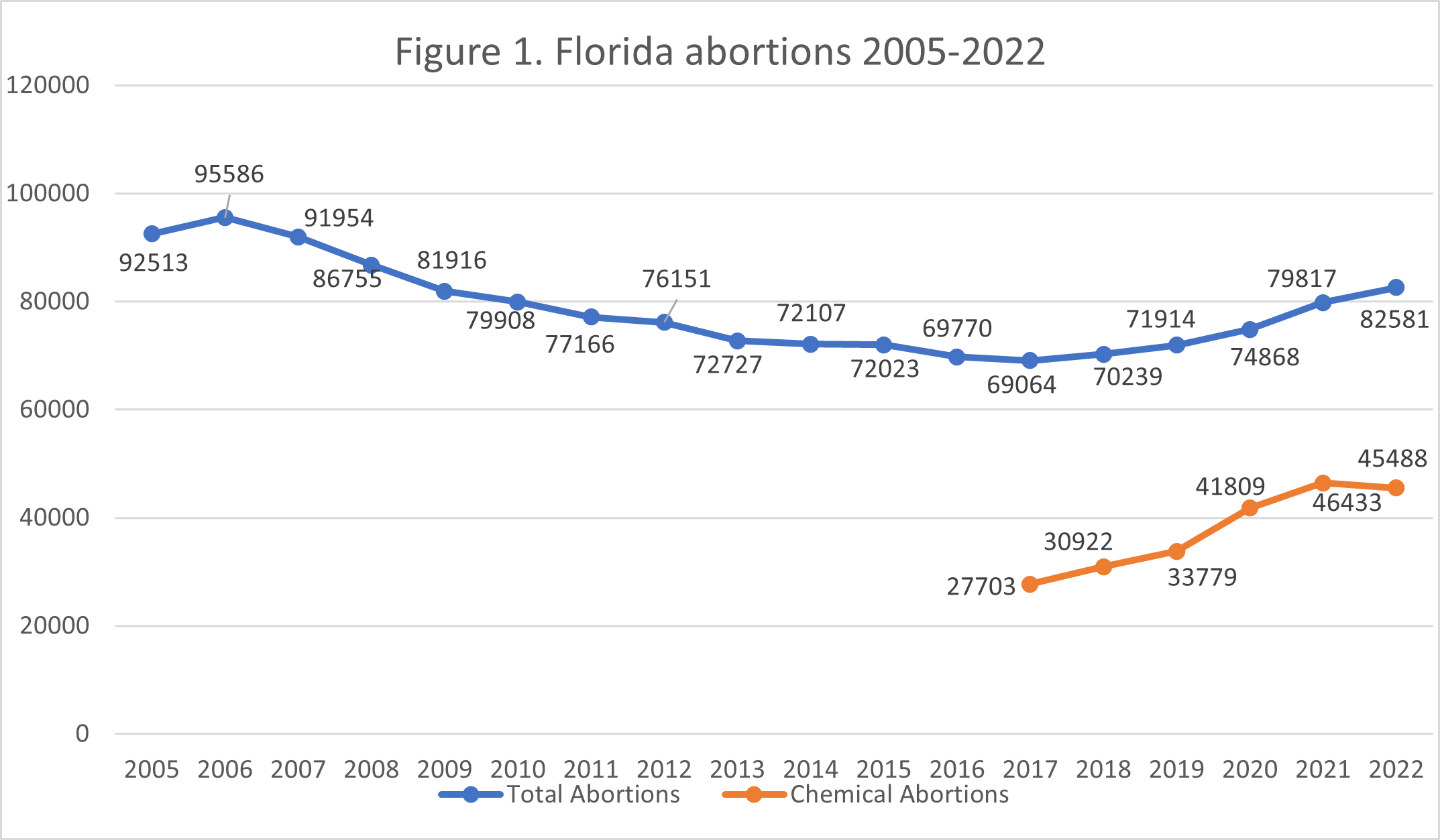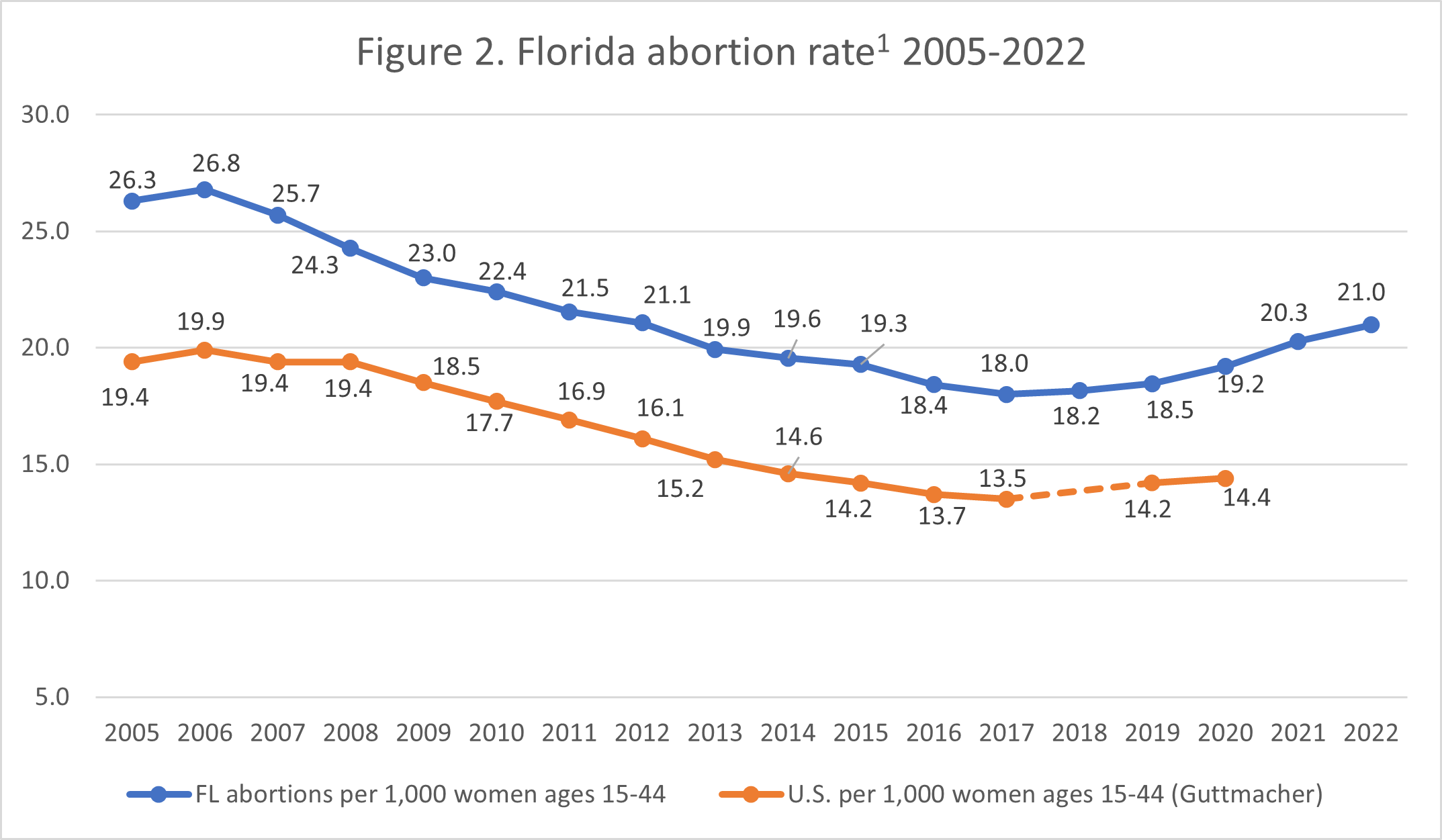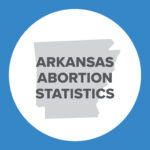Abortion Reporting: Florida (2022)
Florida publishes some of its abortion reporting tables on the state’s Agency for Health Care Administration (AHCA) website. The full report was provided to the Charlotte Lozier Institute (CLI) upon request in June 2023. This is CLI’s third published summary of a state’s 2022 abortion statistics.
Statistics and Changes in Florida Abortions, 2021-2022

This report does not include information on Planned Parenthood’s Florida abortion market share.
Abortion Totals and Trends
Nearly 82,600 abortions were reported in Florida in 2022, an increase of three percent from the previous year. Of the 82,581 abortions performed in 2022, 45,488 were chemical abortions, amounting to 55 percent of the total and down two percent from 2021 (Fig. 1). CLI estimates that Florida’s 2022 abortion rate was 21 abortions per 1,000 women ages 15 to 44, up 3.5 percent from 2021 (Fig. 2).
CLI further estimates that 1,998 abortions at 15 weeks gestation or later were performed in Florida in 2022.
State Report Summary
Ninety-two percent of Florida abortions were reportedly performed on state residents in 2022, while eight percent were performed on nonresidents. The latter abortions included 2.8 percent performed on women from Georgia and 1.8 percent on women from Alabama. Seven percent were performed on girls under the age of 20, twenty-seven percent on women ages 20 to 24, and 28 percent on women ages 25 to 29. A third of Florida abortions were performed on women in their thirties, and four percent were on women ages 40 and older.
Forty-nine percent of the abortions were performed on white women, and 37 percent on black women. CLI estimates that Florida’s black abortion rate was 37.3 abortions per 1,000 women of childbearing age, nearly three times the white rate of 14.4. Eight percent were performed on women of other races, while six percent were on women of unknown races. Thirty percent of Florida abortions were on Hispanic women, 65 percent on non-Hispanic women, and six percent on women of unknown ethnicity.
Twelve percent of the abortions were on married women and 74 percent on unmarried women, while 15 percent were obtained by women whose marital status was not reported. Forty percent of abortions were performed on women with no previous live births, a quarter on women on with one live birth, and 34 percent on women with two or more live births. Over half the women undergoing abortions (58 percent) reported zero prior abortions, while 24 percent reported one prior abortion and 18 percent more than one previous abortion.
More than half the abortions reported in Florida in 2022 were chemical (55 percent). Forty-two percent were curettage procedures, and a different or unreported method was used for three percent. Three abortions were performed via hysterotomy or hysterectomy.
In 2022, Florida began measuring gestational age from the last menstrual period rather than from the estimated date of fertilization, as it did in previous years. Fertilization typically occurs approximately two weeks after the last menstrual period. As reported using the new definition, fifty-six percent of 2022 Florida abortions were performed at six weeks gestation or earlier. Twenty-three percent were performed between seven and eight weeks, and 11 percent occurred between nine- and 10-weeks gestation. Five percent were performed between 11 and 12 weeks, three percent between 13 and 14 weeks, and one percent between 15 and 17 weeks. There were 572 abortions (0.7 percent) performed between 18- and 20-weeks gestation and 213 abortions (0.3 percent) performed at 21 weeks gestation or later.
Overall, the total number of later-term abortions (15 weeks gestation through 21 weeks or later) decreased by 47 percent from 2021 to 2022. It is important to note that due to a change in the definition of gestational age, abortions at 15+ weeks in the 2022 report should be comparable to abortions at 13+ weeks in the 2021 report. The report does not indicate whether data was adjusted to match Florida’s updated definition of gestational age, and the Florida Agency for Health Care Administration (AHCA) did not respond to a CLI request for clarification. This could be the result of Florida’s law protecting unborn babies after 15 weeks of gestation (HB 5), which passed in April 2022 and went into effect on July 1 of that year. Seventy-two percent of Florida abortions were reported as “elective,” 23 percent were performed for social or economic reasons, and two percent were performed for the mother’s emotional or psychological health. In contrast, only one percent were performed for the mother’s physical health and just under one percent (0.8 percent) were performed because the unborn baby had an abnormality (0.7 percent for a “serious abnormality” and 0.1 percent for a “fatal abnormality”). There were 175 abortions (0.2 percent) performed because of risk to the mother’s life, 115 (0.1 percent) due to rape, and seven due to incest. Zero abortions were due to human trafficking.
Sixteen babies were reported to have been born alive during abortion procedures in Florida in 2022, an increase from four babies reported being born alive in 2021. The report does not indicate the gestational ages of the babies or what happened to them after they were born.
Abortion Clinic Annual Report
In accordance with Section 390.012 (8) of the Florida Statute code, AHCA must submit a report to the President of the Senate and Speaker of the House of Representatives recapping all regulatory actions related to abortion centers taken by the agency over the course of that year. AHCA’s 2022 report reveals some interesting and disturbing statistics about operative abortion clinics in the state:
- There were 52 licensed abortion clinics (excluding licensed hospitals and physicians’ offices) in 16 counties. Forty-two of the 52 clinics were licensed as first- and second-trimester abortion clinics, while 10 were licensed for the first trimester only.
- 100 percent of the required induced termination of pregnancy (ITOP) reports were submitted by licensed abortion clinics.
- The agency conducted 151 on-site inspections with 113 being licensure inspections and 38 being complaint inspections.
- Three clinics requested that their licensure be terminated.
- AHCA initiated 31 administrative actions in response to 17 administrative complaints and 14 late ITOP submissions.
Concerningly, “Deficient practice” was found during five of the licensure inspections and 22 complaint investigations. The most common type of deficient practice cited was the failure to inform patients of the nature and risks of the abortion at least 24 hours before the procedure. This violation occurred 15 times. Other concerning violations include one instance of a clinic failing to “perform surgical procedures in accordance with obstetrical standards,” one instance of a clinic neglecting to record parental consent, two cases of failure to ensure that clinic staff were appropriately trained in caring for patients during recovery, and two cases of first trimester-only clinics performing abortions after the first trimester. Other violations can be seen on pages 3-4 of the report.
While the state does not provide the public with complications data when it shares its ITOP data, complications data for any incident resulting in serious injury to a patient or viable fetus during a second-trimester abortion is recorded in the annual clinic report. In 2022, eight second-trimester clinics submitted a total of 16 reports containing a total of 17 injuries: 11 cases of excessive bleeding/hemorrhage, three cases of a perforated uterus, two cervical injuries and one case of damage to other organs. Four of these complications required hospitalization.
Legislative Changes
In April 2023, Florida Governor Ron DeSantis (R) signed SB 300, the “Heartbeat Protection Act,” into law.” Among other pro-life provisions, this bill limits abortion after six weeks gestation, as that is often when an unborn baby’s heartbeat can be detected. Unlike other heartbeat bills, which limit abortion based on the detection of a heartbeat, this bill limits all abortions after six weeks gestation regardless of whether a heartbeat has been detected. The Heartbeat Protection Act allows abortions after six weeks gestation if a mother’s life or a major bodily function is endangered physically; if the pregnancy is a result of rape, human trafficking, or incest and the pregnancy has not progressed past 15 weeks gestation; and/or if the fetus has a “fatal fetal abnormality.” This bill, while signed into law by the governor, will not go into effect until 30 days after any of the following occur:
- A decision by the Florida Supreme Court stating that the Florida’s constitutional right to privacy does not include a right to an abortion.
- A decision by the Florida Supreme Court in Planned Parenthood v. State ruling that Florida’s 15-week law, which is currently in effect, can remain in effect and is constitutional.
- The Florida State Constitution is amended to clarify that S. 23, Article 1 of the State Constitution (the right to privacy) does not include a right to abortion.
- A decision from the Florida Supreme Court reversing In re T.W. (Fla. 1989), North Fla. Women’s Health v. State (Fla. 2003), or Gainesville Woman Care, LLC v. State (Fla. 2017).
State Ranking
In CLI’s 2016 survey of abortion reporting across the country, Florida was ranked at 40th best. The Sunshine State significantly improved its reporting standards in 2017, but could make further improvements by providing more information about the babies who survive abortions, as 2022 saw the highest total of born-alive babies since Florida started reporting this information in 2013.


1. Rates were calculated by CLI using the following formula: (total number of abortions performed in Florida ÷ number of resident women ages 15-44) x 1,000. Rates may differ slightly from previous CLI articles due to revised population estimates. Population estimates were obtained from the CDC WONDER database. Estimates for 2005-2009 are intercensal estimates of the July 1 resident population. Estimates for 2010-2019 are Vintage 2020 postcensal estimates of the July 1 resident population. Estimates for 2020-2022 are Vintage 2021 postcensal estimates of the July 1 resident population as 2022 population estimates have not been released by the CDC. Estimates were produced by the U.S. Census Bureau and the National Center for Health Statistics.



























